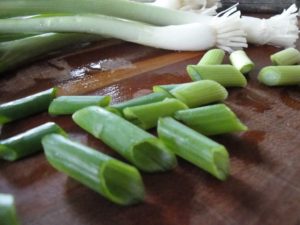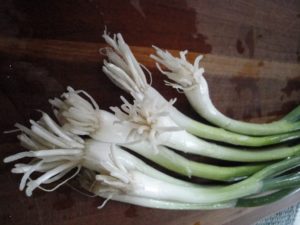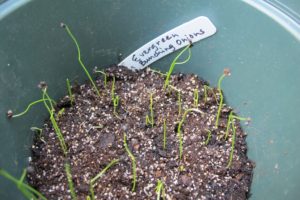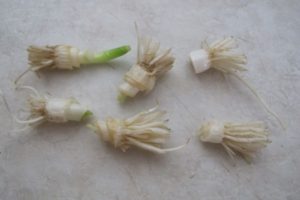updated 3/8/2024
The Onion Patch
In a patch of soil under the cold frame in the old Maryland garden, I grew several dozen Japanese bunching onions. Although the frame was cold in the winter, it didn’t freeze, and those little plants provided us with all the green onions we needed for 5 or 6 years without replanting!
So, how do you get sustainable bunching onions? After describing two species of onions and sowing seeds, I’ll explain the “sustainable” part.
Two Species of Onions
Allium Cepa, the Bulbing Onion
Allium cepa is the commonly grown bulbing onion. Onion sets, small immature bulbs, can be purchased from garden centers in late winter and sometimes in autumn. Plant onion sets a few inches underground, and pull them as green onions before they form bulbs. Planting sets every couple of weeks will provide a continuous harvest.
Left longer in the garden and spaced properly, though, the bulbs will grow larger. Your garden’s latitude, which affects day length in the growing season, will determine which onion varieties will successfully form bulbs. Short-day onions are grown in the southern United States, and long-day or intermediate varieties are grown farther north.
Check with your local agricultural extension office for names of varieties that will mature as bulbs in your region. Bulbing onions also can be grown from seed or purchased in bunches of young seedlings, but most varieties require more than 110 days to mature.
Allium Fistulosum, the Bunching Onion
The variety I grew in the cold frame was called ‘Nabechan’. This variety is a member of the species, Allium fistulosum. Japanese bunching onions, or scallions, don’t grow bulbs. Several varieties are available, and all remain straight-sided, with minor swelling at the base. Bunching onions are available as seeds for home gardeners.
Bunching onions are the ones usually sold in small bunches at the grocery store (photo, above). I use them in salads, omelets, stir-fries, and soups. Once or twice a week, I add a green onion to the spinach, mushrooms, a colorful lunchbox pepper, and kale in the veggie omelet. It’s really good with cheese and microgreens or slices of avocado in the fold…maybe some bacon on the side, and rye toast.
Although both species of onions can be harvested as green onions, the ones I sold at farmers’ markets were ‘Nabechan’ bunching onions. They were ready for the market when the 15 or 20 seedlings in 6″ or 6½” pots approached a harvestable size. Here’s how to grow them, if you’d like to give it a try.
Starting Seeds For Bunching Onions
Sow the seeds 1/4″ deep and about 1/4″ apart in 6″ pots filled with seedling mix. Water gently, so the seeds aren’t dislodged. They germinate well at temperatures around 70° to 80° F.
When the seeds germinate, give them full direct sunlight (6 hours at least), and lower the temperature. They thrive with cool to moderate temperatures, but avoid subjecting them to frost at this early stage. Inadequate light creates weak seedlings and feeble roots.
Keep the soil moist. Onions have shallow roots, and fail when grown too dry. Fertilize every 2 weeks with fish emulsion, Sea-Plus, or any complete fertilizer.
Transplanting Seedlings Of Bunching Onions
Once they’ve grown a few inches tall and are easier to handle, the seedlings will need to be spaced farther apart.
First, fill the new pot or pots with dampened potting soil to within 4-5″ of the rim. Yes, that seems too low, but more potting soil will be added as the seedlings grow. Firm it in lightly.
Where To Place the Crown
Now, gently ease the young plants and the soil mass out of the pot. Don’t let exposed roots dry out during this process. Cover them with a damp towel as you work.
You’ll see the 3 main parts of the onion: the green leaves, the white roots, and the region between the leaves and the roots, called the crown.
Hold up the seedling’s leaves and transplant it into the new pot. Space seedlings 3/4-1″ apart. It might be easier using a pencil to poke a hole into the soil for the roots. Plant with the crown at the soil surface, and lightly firm the soil around its roots. Add a small amount of potting soil over the bases of the stems to stabilize them. Plant them in wider nursery pots, if you choose, where they can remain until harvested. But they won’t require a deep pot.
Water the seedlings and place the pot in direct sun. But avoid harsh hot sun for a couple of days while the roots recover.
Growing Long White Stems
The trick to getting those long white stems is simply to plant the seedlings lower in the soil. Excluding light prevents chlorophyll from developing, blanching the stem. Leeks, another member of the Amaryllidaceae family, get their long white stems in the same way.
Every 10-14 days, add soil between the seedlings, an inch or so at a time, while holding the leaves upright. Although this sounds contrary to normal horticultural practices, the onions will recover. Chlorophyll in the covered stems will be reabsorbed by the plants.
Older leaves will turn brown and can be removed. But strong new foliage will emerge while the underground stem continues to thicken. It’s important to give seedlings full sun for optimal photosynthesis.
The pot is finished when the soil surface is about 1″ below the rim of the pot. The bunching onions will have 4″ or 5″ of white stem below the green leaves (longer than in the photo of store-bought onions, above).
Introduce the seedlings to stronger sun and cooler temperatures outside in the daytime. Protect them from frost while they’re hardening off. With good growing conditions (direct sun, moderate to cool temperatures, moist soil, and fertilizer every 2 weeks), the onions can remain in pots until they’re harvested.
Here’s Another Method of Seeding Bunching Onions
In the photo above, I started seeds about 1½” above the bottom of a 6½” pot, and spaced them farther apart. Adding soil every couple of weeks blanched the stems. Spacing them farther apart from the beginning obviates the need for transplanting.
I tilted the pot on the plant stand outside so the seedlings could catch the rays of the low sun during the shortest days of the year. On cold nights, the pot came indoors. These are seedlings of a variety called ‘Evergreen’.
Planting Bunching Onions Outdoors in the Garden
If you want to grow bunching onions in the ground, plant the pot of seedlings as a unit, covering the stems with 1″ to 2″ of soil. With good soil preparation and careful monitoring, young seedlings can be transplanted into the garden at this stage, weather permitting.
Seeding directly into prepared garden soil is another option if you can monitor progress and keep pests away. Remove weeds when they’re small; onions’ roots can be damaged even with shallow cultivation. By the way, deer and rabbits don’t eat onions.
As the seedlings grow, occasionally hill up soil around the base of the plants to lengthen the white stems. Within about 2 months of seeding, the bunching onions are ready to pull as needed in the kitchen. Younger plants are especially delicate and tender as a garnish. If they’re spaced an inch apart, the seedlings won’t need to be thinned.
Non-bulbing onions are easier to pull from the soil than other types of green onions that have begun to form bulbs. That’s why I prefer growing Japanese bunching onions for green onions. If needed, use a narrow trowel or a butter knife to help pry them from the soil if you want to harvest the whole plant or if bulbs have started forming when using onion sets.
Negi Onions
Bunching onions traditionally are sown in cell packs with several seeds per cell. Later, they’re planted out without separating the seedlings, allowing them to grow and be harvested as a “bunch”. But, in order to grow “sustainable” bunching onions, they need to be grown separately from each other.
In the popular “Negi” method of growing bunching onions, seedlings are spaced farther apart from the beginning and hilled deeply over time. These scallions are older and larger than the ones I grow, resembling leeks.
Here’s the Sustainable Part
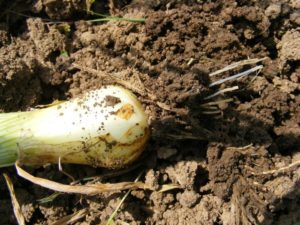
This is where bunching onions become sustainable bunching onions.
Instead of pulling out the entire plant when harvesting, insert a knife into the soil a few inches, making a cut through the stem 1/2″ to 2/3″ above the root system. By leaving the bottom of the stem and the roots intact, the plant will regenerate and give you another green onion after 2 or 3 weeks of favorable weather!
Experience will sharpen your aim, but whether the stem was cut too high or too low, it doesn’t matter. It’s all edible. If you removed the whole stem accidentally, just cut off the bottom 1/2″, with roots, and replant 2″ below ground. It’ll take longer to grow, but it probably will survive.
With some protection in colder climates, it’s possible to harvest mature bunching onions all winter long. That’s why I grew them in a cold frame. Just be sure to plant enough of them. Depending on the temperature, they might remain semi-dormant and not regrow until the soil warms up. And what a surprise to see them vigorously re-emerge in the spring to provide another year of harvests!
“Can I Plant Bunching Onions From the Store?”
Sure can! Buy a bunch of green onions (as in the photo at the top), looking for those with clean white roots. Choose the stems you intend to use in cooking, and cut 1/2″ above the crown. Don’t let them dry out, and plant 2″ deep into a pot of lightly moist soil as soon as possible. Adding more soil later will lengthen the white part of the stem. Cut stems initially planted too deeply might exhaust themselves before reaching the light.
In the photo above, I cut these bunching onions over a period of a few days, and placed them in a clear plastic bag with 2 drops of water. Until a pot of soil had been prepared, the bag sat on the counter, in bright indirect light. You can see the older ones already sprouting. Growing onions in water, even short term, can turn them mushy and really smelly. That’s why planting them directly in soil is preferred.
Keep the pot moist and sunny, and you’ll see a green onion growing probably within 7 to 10 days during the growing season. In the middle of cold winter weather, though, keep the pot in a cool but sunny window indoors or in a cold frame. Soil that freezes could kill the root at this stage. Pick the entire plant or cut the stem when it has grown to the desired size.
Bottoms Up!
If you’re growing green onions from onion sets, this is one of the easiest crops to grow. Seedlings take a little more patience. Because they retain good flavor and substance for a long time, you can harvest what you need and let the rest of the bunching onions continue to grow. Sometimes, all I need is a single green leaf for a small omelet or a garnish.
Here’s to sustainability! Oh, and the reason why those ‘Nabechan’ bunching onions in Maryland failed after several years: contractors replacing the siding on the house trampled them to mush.
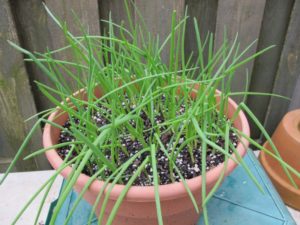
These were planted as onion sets in late winter, before starting seeds of bunching onions. They’ll be harvested as green onions or when they have small bulbs.
